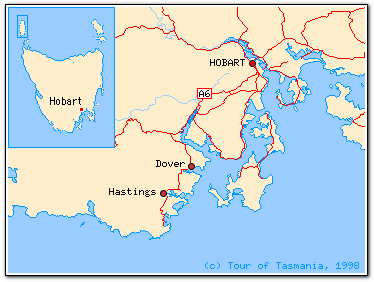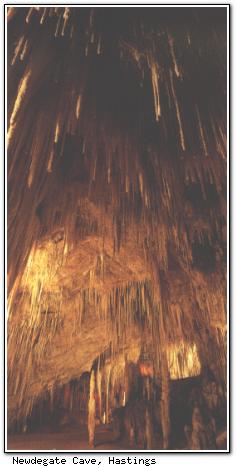Dover  (pop ~500) is a small town in the far south of Tasmania. Dover progressed from a convict station to a sawmilling town, and is currently a fruit growing and fishing (both the traditional and fish farming means) town. Dover's unspoiled beaches provide excellent fishing. A "vintage" yacht can be chartered for either sightseeing or fishing expeditions. (pop ~500) is a small town in the far south of Tasmania. Dover progressed from a convict station to a sawmilling town, and is currently a fruit growing and fishing (both the traditional and fish farming means) town. Dover's unspoiled beaches provide excellent fishing. A "vintage" yacht can be chartered for either sightseeing or fishing expeditions.

 Southwest of Dover is the tiny township of Hastings
Southwest of Dover is the tiny township of Hastings  . It is best known for the Hastings Caves State Reserve. Unlike most caves in Australia, which are formed from water action on limestone, Hastings Caves occur in dolomite. Newdegate Cave . It is best known for the Hastings Caves State Reserve. Unlike most caves in Australia, which are formed from water action on limestone, Hastings Caves occur in dolomite. Newdegate Cave  is illuminated and has guided tours. is illuminated and has guided tours.
Close by is the Hastings Thermal Swimming Pool, a naturally heated spring-fed pool with an average temperature of 28°C (82°F). The Hastings Forest Tour is a self-driven 90 minute journey which provides an alternate route to return to Dover. Commentary is given on a cassette tape.
The Ida Bay  railway is close to Hastings. It was originally built to carry quarried rock, but carries passengers along a scenic section of track with picnic facilities available. railway is close to Hastings. It was originally built to carry quarried rock, but carries passengers along a scenic section of track with picnic facilities available.
Cockle Creek, around 15 km (10 mi) from Hastings, is the southern-most point of Australia that can be reached by car.
Dover has one 4-star and one 3½-star accommodation facility (RACT rated).
© 1995-2010
|






 Southwest of Dover is the tiny township of Hastings
Southwest of Dover is the tiny township of Hastings